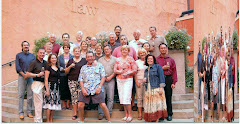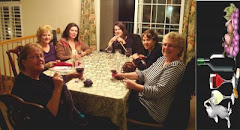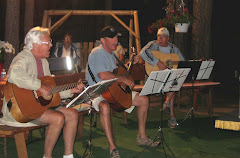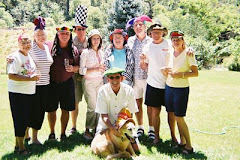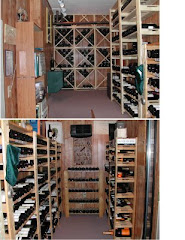Thursday, December 18, 2008
1984 Forman Cabernet
12/17/08-The Wednesday Knitters enjoyed another brown bag older cabernet. The 84 Forman had held up marvelously over time and presented a very fruity, youthful wine. The participants guessed it as a California wine due to its intense fruit, with flavors of black cassis and leather/coffee. Tim Curtis went back two more times and as before, Ann Vik chose it for her dinner wine. The wine had deposited significant sediment, more than I can ever remember for an older wine. This properly cellared wine was a good contrast with the previously tasted 84 Clos du Bois.
Tuesday, December 16, 2008
Champagne Tasting
12/15/08-Gary Rose and Laura Laskowski hosted a Monday night brown bag Champagne tasting for the knitters. The lineup was 7 French Champagnes and 1 California sparkling wine, all recommended by Carrie Boyle, manager of the new Total Wines store in Roseville. Four wines were in the price range of $25-$40 and four at $10-$12. As one might expect, the pricier wines came in first, second and third. The $30 Oudinot did not show as well; however, our local Champagne aficionado, Kathy Hennige, had it as her third choice. The Paul Georg Brut was clearly the favorite of the group, getting 5 first place votes out of 9. Thanks Gary and Laura for a great evening.
PLACE WINE PRICE BOTTLE#
1 Paul Georg Blanc de Blanc $30 8
2 Pertois-Moriset Brut $30 1
3 Perrier-Jouet Brut $40 3
4 St. Germain Brut $10 2
5 Louis Bouillot Brut $12 4
6 Oudinot Cuvee Brut $30 5
7 Korbel Brut $10 7
8 Francois Montand Brut $10 6

PLACE WINE PRICE BOTTLE#
1 Paul Georg Blanc de Blanc $30 8
2 Pertois-Moriset Brut $30 1
3 Perrier-Jouet Brut $40 3
4 St. Germain Brut $10 2
5 Louis Bouillot Brut $12 4
6 Oudinot Cuvee Brut $30 5
7 Korbel Brut $10 7
8 Francois Montand Brut $10 6

Sunday, December 14, 2008
1984 Clos Du Bois Cabernet
12/10/08-Tim and Jane Curtis hosted the Wednesday Wino Band practice and provided a brown bag 1984 Clos Du Bois cabernet that had suffered years of abuse and neglect. The wine was not unpleasant; however, it had little resemblance to its youth and tasted more like sherry wine. This wine demonstrates the value in proper cellaring, inasmuch as we have sampled numerous 1984 cabernets that were cellared at 58 degrees, and they had stood the test of time and provided enjoyable drinking (Acacia, Forman, Laurel Glen, Caymus, etc.).


Friday, December 5, 2008
1976 Ch. Lagrange 1976 Ch. Cos d'Estournel
12/3/08-The Wednesday Knitters enjoyed a comparison of two 1976 Bordeaux wines, a lesser known third growth wine (LaGrange) and a more expensive second growth wine (Cos d’Estournel). The Lagrange had not aged well with significant browning and hints of vinegar, whereas the Cos was still quite fruity, little browning and flavors of red cassis and coffee. All seemed to enjoy the Cos and Ann Vik preferred it over 6 fruity young wines for her dinner wine.


Saturday, November 22, 2008
1980 Montevina Barbera
11/19/08-The Wednesday Knitters enjoyed a rare brown bag treat with the 1980 Montevina Barbera. Everyone to a person enjoyed the wine; intense blackberry fruit, licorice, coffee, deep color with little browning. Barbera appears to age like a petite sirah, retaining intense fruit for decades. A truly pleasant experience.
Thursday, November 13, 2008
1979 Mayacamus Pinot Noir
11/12/08-The knitters enjoyed another brown bag marvel with the 1979 Mayacamus Pinot Noir. The wine was poured into a cabernet bottle to avoid the wider pinot bottle, and it was a sangiovese evening pared with pork, so the varietal guesses were quite varied. For example, Ann Vik wanted to guess pinot but kept it to herself (she claims), Keith Faust guessed sangiovese but amazed the group by guessing it was a 1979 (did they make California sangiovese in 79?). Everyone seemed to agree that it was light, smooth, youthful, fruity, and very enjoyable. 

Tuesday, November 11, 2008
Jordan Cabernet Vertical
7/4/06 (4th of July Bash)-In 1978 the two “hot” wines were the first release of the Jordan cabernet (1976), and the Ch. St. Jean Robert Young Vineyards chardonnay. The Jordan cabs were flying off the shelves and most people purchased it by the case. The wine was smooth as silk, very fruity, little tannin and complex flavors. The 1977 Jordan was a huge disappointment for most people, having a strong vegetal component. The 1978 Jordan was the first from their own vineyards, and was an enormous success; a more conventional cab than the 76, with the potential for ageing.
The surprises of the Jordan vertical were twofold: (1) the 1976 had aged very well, and despite coming in last in the judging, was very pleasant, and (2) the 1977 had lost its vegetal component (as did the 3 Jekel cabernets reported in an earlier post). Following are the tasting notes and ranking by the 18 participants:
RANK YEAR NOTES
1 1983 Good fruit and finish, black cherries
2 1980 Young and fruity, very complex flavors, good finish
3 1982 Pleasant nose, good up front fruit
4 1981 Mouth filling, still a bit tannic, slight vege component
5 1978 Olives/green pepper, chocolate, cherries
6 1979 Red currants, seamless
7 1977 Similar to 76 but a bit more fruit and tannin
8 1976 Soft red currant, pleasant, lots of fruit, a bit tart, long finish
The surprises of the Jordan vertical were twofold: (1) the 1976 had aged very well, and despite coming in last in the judging, was very pleasant, and (2) the 1977 had lost its vegetal component (as did the 3 Jekel cabernets reported in an earlier post). Following are the tasting notes and ranking by the 18 participants:
RANK YEAR NOTES
1 1983 Good fruit and finish, black cherries
2 1980 Young and fruity, very complex flavors, good finish
3 1982 Pleasant nose, good up front fruit
4 1981 Mouth filling, still a bit tannic, slight vege component
5 1978 Olives/green pepper, chocolate, cherries
6 1979 Red currants, seamless
7 1977 Similar to 76 but a bit more fruit and tannin
8 1976 Soft red currant, pleasant, lots of fruit, a bit tart, long finish
Lytton Springs Zinfandel Vertical
7/4/05 (4th of July Bash)-The Lytton Springs zinfandel vertical tasting produced numerous very drinkable and enjoyable examples of aged zins. As usual with older zins, they developed tastes more reminiscent of cabernet. 1979 was an outstanding vintage for zinfandels, and the Lytton Springs was the clear favorite of the Northern California Wine Society in several blind tastings in the early 80's. Following are the rankings by the 18 participants:
RANK YEAR
1 1979
2 1980
3 1984
4 1986
5 1981 Private Reserve
6 1985
7 1981
8 1983 Private Reserve

RANK YEAR
1 1979
2 1980
3 1984
4 1986
5 1981 Private Reserve
6 1985
7 1981
8 1983 Private Reserve

Duckhorn Merlot Vertical
5/29/05-All of the Duckhorn Merlot’s tasted were youthful, fruity, complex and extremely enjoyable.
RANK YEAR
1 1983-3 Palms
2 1985
3 1981-3 Palms
4 1981
5 1980
6 1982
RANK YEAR
1 1983-3 Palms
2 1985
3 1981-3 Palms
4 1981
5 1980
6 1982
1980 and 1982 Diamond Creek Cabernet, Volcanic Hill
7/4/06 (4th of July Bash)-The two Diamond Creek Cabs were tasted by approximately 30 members of the Folsom Wine Group. The Volcanic Hill grapes are planted on volcanic ash with a southerly exposure, and typically make the hardest, most tannic and powerful wines compared to the other vineyard specific cabs by Diamond Creek (Red Rock Terrace, Lake and Gravelly Meadow). The 1980 was the clear favorite of the two. Tasting notes were quite consistent with the members and between the two wines; big, fruity, youthful, tannic, plums, some earthiness.
Monday, November 10, 2008
1934 Fonseca Vintage Port
7/4/04-(4th of July Bash) Approximately 30 members of the Folsom Wine Group tasted the 1934 Fonseca Port. This was an incredible experience for all. Expecting an “over the hill” wine, the wine was a silky, fruity, elegant example of an aged port. Most everyone remarked that it was by far the best port they had ever had, and several members who admitted that they did not care for port, came back for seconds. My regret-I only bought one from Corti Brothers.
I purchased this wine at Corti Brothers in the early 80’s. The following notes accompanied the wine:
Directors Special Reserve-Alcohol 20% by volume
Imported December 1975 and purchased by Corti Brothers in the early 80’s.
It is traditional for the directors of wine and spirits merchants’ firms to maintain a sizable stock of fine wines and ports for entertaining clients. The firm of Arthur Bell & Sons, producers of whiskies in Perth, Scotland, bought specially selected pipes of port of the best vintages and bottled them in their Pedrch cellars, not to sell, but to hold for their director’s reserve.
This port has rested since bottling two years after the vintage in the firm’s cellars in Leith, Scotland and rested there until importation in December 1975.
Vintage port produces sediment or crust as it is held in bottle. The inside of bottles is traditionally “shotted” when the bottle is made by shaking the inside of the freshly formed bottle with buckshot. This provides pits in the inside surfaces to which the “crust” or flaky sediment found in old vintage port adheres. In shipping, old ports have this crust broken up by the travel. For this reason, the bottles all have a white mark painted upon one side. When you lay your bottle on its side in your cellar, be careful to place the bottle with the mark facing up so that the port may resume its natural rest.

I purchased this wine at Corti Brothers in the early 80’s. The following notes accompanied the wine:
Directors Special Reserve-Alcohol 20% by volume
Imported December 1975 and purchased by Corti Brothers in the early 80’s.
It is traditional for the directors of wine and spirits merchants’ firms to maintain a sizable stock of fine wines and ports for entertaining clients. The firm of Arthur Bell & Sons, producers of whiskies in Perth, Scotland, bought specially selected pipes of port of the best vintages and bottled them in their Pedrch cellars, not to sell, but to hold for their director’s reserve.
This port has rested since bottling two years after the vintage in the firm’s cellars in Leith, Scotland and rested there until importation in December 1975.
Vintage port produces sediment or crust as it is held in bottle. The inside of bottles is traditionally “shotted” when the bottle is made by shaking the inside of the freshly formed bottle with buckshot. This provides pits in the inside surfaces to which the “crust” or flaky sediment found in old vintage port adheres. In shipping, old ports have this crust broken up by the travel. For this reason, the bottles all have a white mark painted upon one side. When you lay your bottle on its side in your cellar, be careful to place the bottle with the mark facing up so that the port may resume its natural rest.

Friday, November 7, 2008
1979 Ridge York Creek Cabernet
11-5-08-The Knitters enjoyed a brown bag 1979 Ridge York Creek Cabernet that has refused to age. The group was split fairly evenly between being a younger or older wine, and voiced a wide range of varietal guesses. Everyone agreed, however, that it was a very enjoyable experience. Big, fruity, lots of black berry and coffee flavors, little tannin, lots of sediment.
NOTES FROM THE LABELS
Napa County, 88% Cab, 12% Merlot, Spring Mountain, 13.8% alc
In 1979, for the first time, we were able to make each cabernet block at York Creek separately. The resulting wines confirmed the notable effect that soil and exposure can have. Although some blocks stood out, the finest, most complex wine was the combination of all but one. As it develops, oak from the small cooperage will contribute a further dimension to the peppery cabernet fruit so typical of this vineyard. With four to five years of bottle age, it should be showing its full quality.
NOTES FROM THE LABELS
Napa County, 88% Cab, 12% Merlot, Spring Mountain, 13.8% alc
In 1979, for the first time, we were able to make each cabernet block at York Creek separately. The resulting wines confirmed the notable effect that soil and exposure can have. Although some blocks stood out, the finest, most complex wine was the combination of all but one. As it develops, oak from the small cooperage will contribute a further dimension to the peppery cabernet fruit so typical of this vineyard. With four to five years of bottle age, it should be showing its full quality.
1995 Vieux Telegraphe
11/1/2008-The entire Folsom Wine Group met at the home of Steve & Teri Price for their annual halloween party. There were approximately 50 wines tasted at the event. There were some outstanding wines tasted but the hit of the evening was a magnum of 1995 Vieux Telegraphe Chateauneuf Du Pape Rhone wine provided by Lionel Wade. The wine was incredibly fruity, balanced, with a very long finish, and disappeared so quickly that few people got a second taste. Thanks Lionel for a great experience.
Friday, October 24, 2008
1980 Chateau Montelena Chardonnay
10/22/08-The brown bag tasted at the Knitters weekly dinner was the 1980 Montelena Chardonnay in celebration of the current movie Bottle Shock. The dinner host Laura Laskowski nailed it as being a Grgich chardonnay. Understanding that Mike was the winemaker for the 1973 chardonnay that won the shootout in France, and left shortly thereafter to start his own winery, the winemaking style and grapes at Montelena were probably very similar in 1980. The wine was an incredible treat. The color was a brilliant gold and the wine had intense fruit of sweet apples with absolutely no negatives. In the past the older brown bag wines were rarely finished, the 12 participants were usually satisfied with a small sip to evaluate the wine. This chardonnay was totally consumed before dinner began. Kudos to Mike and Ch. Montelena.
Sunday, October 19, 2008
1976 Souverain Cabernet 1976 Joseph Phelps Cabernet
5/16/07-The Wednesday wine group tasted the 76 Souverain and 76 Joseph Phelps cabernets. An interesting contrast. The Souverain was unbelievable good, quite fruity with red currant flavors and very little tannin, little browning and enjoyed by all. The Phelps was a much bigger wine, very dark with flavors that leaned toward coffee, tobacco and cedar, not enjoyed by some and some went back for seconds (and even thirds).
Opus One Vertical--1986 Mouton Rothschild
7/4/08 (4th of July Bash) Vertical Opus One-1986 Mo
Opus One 1979 (first release), 1980, 1981, 1982, 1983, 1984, 1990, 2004
1984-1st Place-Very fruity, lots of sediment, berry, plum.
1982-2nd Place-Excellent fruit, still young wine, bigger and more tannic than 84.
1979-3rd Place-Red currants & tobacco/earth, balanced, smooth, still healthy, tannin’s gone.
1981-4th Place-Fruity, mouth filling, big, some tannin.
1983-5th Place-Austere compared to others, pleasant and smooth. Red currants.
1980-6th Place-Bigger than others and not quite as fruity (1980 record summer heat) some tannin.
1990 & 2004-Young, needs more time, ripe blackberry fruit, long finish.
The 1986 Mouton (100 Points Robert Parker) lived up to its pedigree; elegant, intense,complex fruit, mouth filling, long finish, still with lots of life left.

Opus One 1979 (first release), 1980, 1981, 1982, 1983, 1984, 1990, 2004
1984-1st Place-Very fruity, lots of sediment, berry, plum.
1982-2nd Place-Excellent fruit, still young wine, bigger and more tannic than 84.
1979-3rd Place-Red currants & tobacco/earth, balanced, smooth, still healthy, tannin’s gone.
1981-4th Place-Fruity, mouth filling, big, some tannin.
1983-5th Place-Austere compared to others, pleasant and smooth. Red currants.
1980-6th Place-Bigger than others and not quite as fruity (1980 record summer heat) some tannin.
1990 & 2004-Young, needs more time, ripe blackberry fruit, long finish.
The 1986 Mouton (100 Points Robert Parker) lived up to its pedigree; elegant, intense,complex fruit, mouth filling, long finish, still with lots of life left.

1978 & 1979 Jekel Cabernet
10/15/08-Jekel 1978 & 1979 Cabernet Reserve and 1978 regular cabernet.
These wines were tasted in the early 80's by the Northern California Wine Society, and at that time exhibited very intense vegetal flavors. Surprisingly, the vegetal component was not apparent in these wines, and all three were showing excellent ageing, with minimal browning and no negatives. The 79 was particularly enjoyable and one member chose it over numerous young wines for her dinner wine. Excellent examples of California cabernet ageability.

These wines were tasted in the early 80's by the Northern California Wine Society, and at that time exhibited very intense vegetal flavors. Surprisingly, the vegetal component was not apparent in these wines, and all three were showing excellent ageing, with minimal browning and no negatives. The 79 was particularly enjoyable and one member chose it over numerous young wines for her dinner wine. Excellent examples of California cabernet ageability.

Blog Purpose
The blog entries describing wines tasted by the Folsom Wine Group are the result of wine activities and parties conducted at members homes and wine tasting at Lakeside Beverages in Granite Bay on Friday nights. Activities include a smaller group of knitters/guitar players/wine tasters that meet each Wednesday night, and a half dozen full member annual parties conducted each year (Halloween, 4th of July, pool party, rib shootout, Italian party, Cajun party, burgers and Bordeaux, etc.).
Subscribe to:
Comments (Atom)






